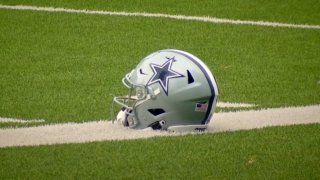
As the second hour of mandatory minicamp practice begins at Ford Center at the Star in Frisco, Cowboys defensive backs are summoned for what feels like an afterthought of a drill.
The six-minute exercise is overlooked by most, blending in amongst the whistles, passes and punts. But this training session is one of the most important the Dallas DBs will experience during offseason workouts.
Disguising coverage, or “changing the picture post-snap,” is now one of the most important things a team must do in modern football.
It's a topic Cowboys safety Jayron Kearse is passionate about, and discussed at length during a conversation that started about the safety position in the NFL, and how it has changed in the last few seasons.
Get DFW local news, weather forecasts and entertainment stories to your inbox. Sign up for NBC DFW newsletters.
“I feel like we’re getting to a point now, especially with a lot of unique players like myself and the kid who just came out of Notre Dame, (Baltimore Ravens draft pick) Kyle Hamilton, and even guys like (New Orleans Saints safety) Tyrann Mathieu, who plays a lot of positions and plays at a high level, that bring something to your defense you can’t just get from everywhere,” Kearse said.
What Kearse brings, at 6 feet 4 inches and 215 pounds, is sought-after versatility as the NFL shifts to defensive schemes that prioritize players in the secondary who can do just about everything.
Defensive football guru Cody Alexander, the creator of MatchQuarters.com and the author of five books specifically about football defense, agrees versatile safety play is the way of football’s future.
“It’s not the way it used to be 10 or 20 years ago,” Alexander said. “The safety position has grown in value because of the way defenses are now structured. Coverage (the defensive backs plan) now predicates the front (defensive linemen and rush plan). You don’t see teams stockpiling linebackers. It’s all about edge rushers and defensive backs.”
Sports Connection
Connecting you to your favorite North Texas sports teams as well as sports news around the globe.
“My size allows me to play in the box and be adequate as a (run-stopping) linebacker,” Kearse said. “And my athleticism and my speed allow me to play back deep and be an adequate safety when it comes to (pass) coverage.”
The athleticism also allows Kearse to quickly break back and forth to multiple spots on the field just as the football is snapped.
Back to the drill.
Cowboys secondary coach Joe Whitt Jr. has two safeties split apart by about 10 yards. He yells multiple calls, presumably telling the players which coverage he wants before and after the ball is snapped. The goal is to keep the post-snap coverage a secret until the absolute last second.
The reason? In today’s NFL, defenses have little chance against the best quarterbacks in the league if, before they snap the ball, the QB correctly figures out where your defensive players are going to be once the play begins.
Patrick Mahomes, Tom Brady, Aaron Rodgers, Josh Allen and the rest of the best in the league will pick apart a defense that is not able to (somewhat) keep them guessing in the short amount of time between when the football is snapped and when they reach the top of their drop back to pass.
Confusion – or what the Cowboys refer to as “mental assault” – is king. And when a quarterback guesses wrong and has to rethink where to go with the ball during that drop back, it requires extra, precious milliseconds.
“And that’s when they have to deal with (Cowboys pass rusher) Micah (Parsons) coming at them with that speed,” Kearse says.
He is certainly not the first to do so, but Whitt has nevertheless created an effective way to practice perfecting the Cowboys’ disguise attack.
Now pretending to be the opposing quarterback, Whitt uses an array of “dummy” snap count calls, hoping to fool the safeties by getting them to show their hand. They don’t bite and stand still in their original pre-snap location.
As he yells “go,” signaling the start of the play, both players break to their new spot, with eyes focused on the line of scrimmage while also hustling to their updated position.
They jog off the field and the next batch of safeties sprint to the 10-yard split locations, waiting for instructions and an opportunity to disguise.
It’s an overlooked drill by most in attendance, seeming like an afterthought exercise, passing the time between passing lines and 11-on-11 walkthroughs.
There may be no better way to describe an important drill emphasizing disguise.